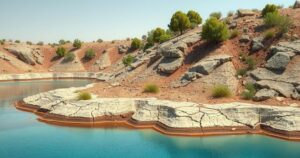Study Clarifies Iran Earthquake Was Not Caused by Nuclear Test

A newly published study refutes claims that a 4.5 magnitude earthquake in Iran was caused by a nuclear test, exposing the misinformation spread rapidly on social media. The research concludes that the earthquake resulted from natural geological processes, not nuclear activity, and underscores the risks of misinterpretation during geopolitical tensions.
Recent research rebuts fears that a significant earthquake in Iran was the result of a nuclear test. The 4.5 magnitude quake, occurring on October 5, 2024, was mischaracterized by some media and social platforms, particularly amidst the existing geopolitical tensions in the region. The study, published in the journal Seismica, emphasizes the dangers of misinformation, particularly in times of heightened international conflict.
Dr. Benjamin Fernando, a seismologist from Johns Hopkins University, indicated that there was a deliberate spread of misinformation regarding the earthquake, which was not typical in seismic events. He highlighted that the geophysical data played a crucial role in addressing these claims. His research team discovered that the quake originated from natural seismic activity linked to the geological features of the region.
Analyzing seismic signals, the research confirmed that the earthquake stemmed from a reverse fault, a common occurrence in the context of the hydraulic pressure from adjacent tectonic plates. Nuclear tests exhibit distinctly different seismic signatures, characterized by explosive patterns rather than the compression-linked movements found in this event. Furthermore, historical data corroborates the assertion that similar tremors in this region had previously occurred without nuclear involvement.
The Comprehensive Test Ban Treaty Organisation (CTBTO) reported similar earthquakes in the same area in 2015 and 2018, both confirmed to be non-nuclear. Despite this evidence, erroneous claims related to the recent quake proliferated on social media within minutes of its occurrence, compounded by individuals misinterpreting seismic data from a different earthquake that took place earlier.
The narrative linking Iran’s earthquake to a nuclear test quickly transitioned to mainstream news, particularly in Indian media, which proliferated misinformation by referencing each other’s unfounded reports. The study’s authors advocate for enhanced cooperation among seismologists for swift fact-checking and the dissemination of accurate scientific information to combat misinformation effectively.
Dr. Saman Karimi from Johns Hopkins emphasized the importance of organizations issuing timely reports to counteract false narratives. She advocated for collaboration between social media outlets and trusted scientific bodies to ensure that verified data is prioritized over misleading information.
The recent earthquake in Iran has drawn attention due to suspicions that it might have been a result of nuclear testing. This suspicion surfaced during a period of increased geopolitical tensions, which led to widespread discussion and speculation on platforms like social media. Assessing the causes of seismic events is critical, especially when misinformation can influence public perception and geopolitical relations. Scientific communities are particularly concerned about the rapid spread of claims that can complicate diplomatic situations and magnify tensions.
The research conclusively demonstrates that the earthquake in Iran was a natural event unrelated to nuclear testing, emphasizing the importance of accurate scientific communication. It highlights the risks of misinformation during politically charged atmospheres and advocates for proactive measures to ensure the integrity of seismic data is preserved in public discourse. The promotion of accurate information from reliable sources can mitigate the harmful effects of false narratives in future occurrences.
Original Source: www.fox28spokane.com






